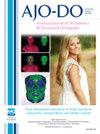Potential for bracket bonding errors based on tray accuracy and fit: Evaluation of 6 photopolymer resins for indirect bonding trays
IF 2.7
2区 医学
Q1 DENTISTRY, ORAL SURGERY & MEDICINE
American Journal of Orthodontics and Dentofacial Orthopedics
Pub Date : 2024-10-10
DOI:10.1016/j.ajodo.2024.08.005
引用次数: 0
Abstract
Introduction
We assessed the accuracy and fit of 3-dimensional (3D)-printed indirect bonding (IDB) trays fabricated using various photopolymer resin materials.
Methods
A maxillary plaster model and 60 plaster replicas were created. IDB trays with arbitrary bracket configurations were 3D-printed using 3 hard resins (Amber [AB], TC85DAC [TC], Orthoflex [OF]) and 3 soft resins (IBT [IT], IDB2 [ID], and MED625FLX [MD]). A reference plaster model with a computer-aided design-designed IDB tray attached with nonfunctional, arbitrary bracket configurations on the buccal surface serving as reference points for measurement was superimposed on scanned plaster replicas holding 3D-printed trays to assess transfer accuracy and clinically acceptable error. Printing accuracy was assessed by comparing computer-aided design trays to printed trays, and tray fit was measured by the gap volume between the tray and plaster replica using a Fit-Checker (GC Corp, Tokyo, Japan).
Results
Six tray groups showed significant linear transfer errors, particularly in the vertical direction (0.15 mm [95% confidence interval {CI}, 0.10-1.15]; P = 0.004). The OF group exhibited the largest vertical error (0.27 mm [95% CI, 0.19-0.35]), whereas the ID group had the smallest (0.10 mm [95% CI, 0.06-0.14]). Angular errors did not exhibit significant differences across the groups. Linear precision error was the highest in OF, followed by ID, TC, and MD, then AB and IT (P <0.001). Of all tray groups, 90.1% and 68.8% met the clinically acceptable linear (<0.25 mm) and angular errors (1°).
Conclusions
Linear errors, particularly vertical errors, are more material-dependent than angular errors. Gap volume alone was not a reliable predictor of IDB tray accuracy. Therefore, material-specific designs are needed to control the optimal fit and facilitate precise bracket placement.
基于托盘精度和配合度的托架粘接误差可能性:评估用于间接粘接托盘的 6 种感光树脂。
简介:我们评估了使用各种光聚合物树脂材料制作的三维(3D)打印间接粘接(IDB)牙托的准确性和密合性:我们评估了使用各种光聚合物树脂材料制作的三维(3D)打印间接粘接(IDB)托盘的准确性和密合性:方法:制作一个上颌石膏模型和60个石膏复制品。使用 3 种硬质树脂(Amber [AB]、TC85DAC [TC]、Orthoflex [OF])和 3 种软质树脂(IBT [IT]、IDB2 [ID] 和 MED625FLX [MD])三维打印了具有任意托槽配置的 IDB 托盘。将计算机辅助设计的 IDB 托盘的参考石膏模型与颊面的非功能性任意托槽配置作为测量参考点,叠加在扫描的石膏复制品上,托盘为 3D 打印,以评估转移准确性和临床可接受误差。通过比较计算机辅助设计的托盘和打印的托盘来评估打印的准确性,并使用 Fit-Checker (GC 公司,日本东京)通过托盘和石膏复制品之间的间隙体积来测量托盘的密合度:六组托盘显示出明显的线性转移误差,尤其是在垂直方向(0.15 毫米[95% 置信区间{CI},0.10-1.15];P = 0.004)。OF 组的垂直误差最大(0.27 毫米[95% 置信区间,0.19-0.35]),而 ID 组最小(0.10 毫米[95% 置信区间,0.06-0.14])。各组之间的角度误差没有明显差异。线性精度误差在 OF 组最大,其次是 ID、TC 和 MD,然后是 AB 和 IT(P 结论):线性误差,尤其是垂直误差,比角度误差更依赖于材料。间隙体积本身并不能可靠地预测 IDB 托盘的精度。因此,需要针对特定材料进行设计,以控制最佳密合度,促进托槽的精确放置。
本文章由计算机程序翻译,如有差异,请以英文原文为准。
求助全文
约1分钟内获得全文
求助全文
来源期刊
CiteScore
4.80
自引率
13.30%
发文量
432
审稿时长
66 days
期刊介绍:
Published for more than 100 years, the American Journal of Orthodontics and Dentofacial Orthopedics remains the leading orthodontic resource. It is the official publication of the American Association of Orthodontists, its constituent societies, the American Board of Orthodontics, and the College of Diplomates of the American Board of Orthodontics. Each month its readers have access to original peer-reviewed articles that examine all phases of orthodontic treatment. Illustrated throughout, the publication includes tables, color photographs, and statistical data. Coverage includes successful diagnostic procedures, imaging techniques, bracket and archwire materials, extraction and impaction concerns, orthognathic surgery, TMJ disorders, removable appliances, and adult therapy.

 求助内容:
求助内容: 应助结果提醒方式:
应助结果提醒方式:


